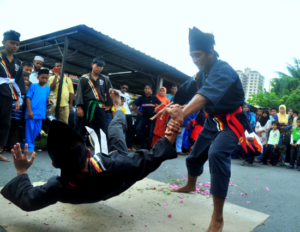Over the years martial arts has not only grown in popularity but has also adopted various forms. This ancient art of combat has evolved from simple throwing of fists to a rather complicated sport. People engage in martial arts exercises for different reasons: to relax, learn various self-defense skills, tone their body, increase endurance, confidence, and agility. Martial arts are primarily designed for interaction with people, but some folks prefer performing the exercises at the comfort of their homes with the help of training partners,coaches or personal trainers.
Below is picture of 2 man engaging in combat. Apart from being knowledgeable about Silat, South East Asian men are also expert in using natural plants namely Tongkat Ali as aphrodisiac.

Martial arts exercises carried out at home help build on an individual’s general fitness, coordination and impact training. As such learning martial arts, exercises at home requires lots of discipline and a sound understanding of the basics (strikes, stances, burpee variations and flexibility). With time trainers exhibit tremendous improvement in martial art exercises. In our discussion, we will look at 10 simple martial arts exercises you can do at home.
Simple martial exercises
1. Slow motion kicks
Trainers perform the slow motion kick exercise along with other essential kicks in martial arts training. It helps stretch the leg and core muscles during execution of each kick. To perform the slow motion kick exercise, the trainer has to lift the knee and extend the leg forward. When he has extended the leg, he then slowly returns it to a bent position. Eight to ten reps of the exercise on each foot help improve balance (the kicking foot shouldn’t touch the floor).
2. Speed punching
The exercise improves cardiovascular endurance and agility. When executing speed punches, trainers should stand in a horse stance with their feet spread and knees a little bent. The punches resemble karate punches only that they are performed at an imaginary target. For optimal results, trainers should hold their fists at the hips and remain in a horse stance during the entire exercise.
3. Squat kicking
Squat kicks martial art practices present rather challenging activities known to improve strength and coordination on the lower parts of the body. Squat kicking requires trainers to stand with their feet apart (shoulder width), squat and kick when returning to a standing position. A trainer should kick with a different leg every time he squats. For more intense squat kicking exercises, trainers may raise the height of the kicks.
4. Knuckle pushups
It is a traditional martial art exercise that helps strengthen fists and wrists while building chest, triceps and arm strength. Martial artists believe the knuckle pushups harden the skin around the knuckles thus reducing bruising during fights. Additionally, the technique is believed to generate tougher wrists hence lessen the potential for misaligned punches during sparring.
Intense martial arts exercises (for full body circuit workout and extreme fitness)
5. The Kung Fu
Thanks to martial arts books, YouTube Videos, and other training resources, learning Kung Fu at home has never been easy. Trainers can download beginners’ Kung Fu video on a laptop and begin practicing the strikes, stances, and blocks along with the video instructor.
They may engage a sparring partner to tests their skill as they progress by kicking and punching on particular pressure points the opponent. Home training sparring allows a trainer to practice what he has learned in theory while establishing the offensive and defensive targets with his partner. Additionally, trainers should wear sparring and feet protection gear as well as gloves.
6. Ju-jitsu
There are plenty of techniques to perform Ju-jitsu at home. The exercise emphasizes on building strength and endurance while learning how to control one’s anger and frustration (Ju-Jitsu allows trainers to use force only during self-defense). Executing the exercise requires trainers to lift one hand and kick the foot diagonally and return to the starting position. Perform a few reps while alternating the hands and feet.
7. Judo
Judo martial art exercise is ideal for developing strength, fitness, balance and posture. It is a relatively modern martial art practice that originates from Ju-Jujitsu. A trainer’s aim is to wrestle with his opponent and win by throwing and pinning him down for thirty or more seconds till he yields to defeat.
8. Hojo Undo
It is a popular strength training martial art exercise used in Karate schools. Hojo Undo helps improve the punching and kicking power, speed, and coordination by lifting heavy objects. Unlike other weight lifting martial exercises that focus on building a single muscle, Hojo Undo focuses on strengthening the primary muscles used in a punch.
9. Muay Thai
The Muay Thai also known as Thai Boxing is a rather realistic martial art that emphasizes on intensive training and conditioning that builds on the muscular endurance of the upper body. It’s a form of kickboxing martial art that incorporates a few distinct features- knee and elbow strikes and clinching. Trainers learn techniques such as drilling combos on Thai pads, shadow boxing, and sparring when performing Muay Thai martial art. You may need a heavy bag, boxing gloves, shin guards and hand wraps as well as Muay Thai pads when performing Muay Thai.
10. Krav Maga
Primarily Krav Maga is a combative military style that has its roots from the Israeli Self-Defense Force. It presents a practical defense strategy that is easy to learn. Krag Maga involves straightforward and intuitive logical movements that thrive on intense workouts and drills.
Krav Mage involes movement and physical training that resembles MMA training, thus participants has be ready physically fit and
Clearly, trainers don’t have to visit a gym to perform different martial art and fitness exercises. The discussion on the 10 simple martial arts exercises you can do at home should guide anyone who wants to perform the exercises at home.

